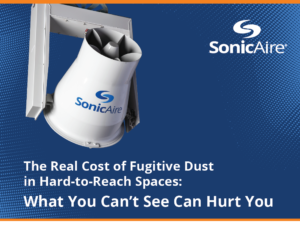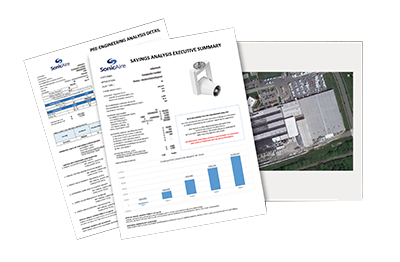Dust—tiny as it may seem, it’s a colossal threat in any manufacturing or processing facility. When combustible dust accumulates, it doesn’t merely settle as a harmless layer of dirt; it lurks as a potent hazard. The smart way to combat combustible dust isn’t just for cleanliness—it’s a critical safety crusade.
The Perils of Ignoring Combustible Dust
In the busy throes of managing a facility, it’s easy to see dust as just another part of the industrial backdrop.
But the stakes are incredibly high. Ignoring it means running the risk of fugitive dust explosions, which can be devastating.
Traditional dust cleaning methods, like scheduled sweeping and vacuuming, have been the go-to for years. However, these methods only offer a temporary fix.
Why?
Because the very next moment, after cleaning, dust begins to settle again, restarting the dangerous cycle.
The Limitations of Traditional Dust Control
Think about the typical dust control routine:
- You halt production (or find scheduled downtime)
- You bring in cleaning crews (your staff or a third-party).
- You use extensive (and often expensive) labor to clean hard-to-reach overhead spaces.
This process not only interrupts your workflow but also poses logistical nightmares. It’s a financial drain.
More critically, the moment these spaces are cleaned, the cycle of dust accumulation resumes. It’s a never-ending battle-one that traditional methods aren’t designed to handle effectively.
By the time you’ve scheduled the next cleaning, dust might have already reached hazardous levels. This reactive method leaves too much room for error.
When you must combat combustible dust, errors can have explosive consequences.
SonicAire’s Revolutionary Approach to Dust Control
Enter SonicAire’s dust control fan systems, designed to tackle the root of the problem by preventing the dust from settling in the first place.
How do they work?
These systems use advanced airflow technology to create a barrier to keep dust particles from rising and settling atop overhead spaces. Continuous prevention is the key—it doesn’t collect dust; it stops it from accumulating.
By integrating these systems, facility managers can maintain a clean environment without the disruptive start-stop routine required by traditional methods.
It’s a smooth, ongoing process operating silently in the background, allowing normal operations to continue without a hitch.
Why Continuous Prevention Makes All the Difference
With SonicAire fan systems, the approach to dust control shifts from reactive to proactive.
Here’s why this change in strategy is crucial:
- Regulatory Compliance Made Easier: Continuous dust control means you’re always several steps ahead of regulations, not chasing them. Facilities maintain compliance without the panic or rush of emergency clean-ups.
- Safety Isn’t Just a Checkbox: By preventing dust buildup, the risk of explosions is dramatically reduced. Safety becomes a built-in feature of your daily operations, not a compliance requirement.
- Operational Efficiency: Your facility runs more efficiently without frequent shutdowns. Continuous dust prevention eliminates the need for extensive downtime, improving productivity and profitability.
- Cost-Effectiveness: Consider the long-term savings when you’re not regularly paying for clean-up operations. Investing in a continuously operating system reduces the need for emergency maintenance and potential fines for non-compliance.
Real Stories from the Field
Like many facilities, Teijin Automotive Technologies (formerly known as Continental Structural Plastics, CSP) manually cleaned their Lenoir, NC facility. With ceilings reaching 45 feet and molding presses that stood 20 feet tall, it was a feat to maintain compliance. According to Tracy Gray, Plant Manager, they had to repeatedly schedule downtime to free up space for cleaning.
One complete cleaning rotation required a total of 96 shifts of downtime. Gray reported, “The final tally for the cleaning service and the overtime required to free up the presses for cleaning was $43,000 per year.”
A SonicAire dust control fan system was installed to eliminate these costly, time-consuming cleanings. According to Gray, “We run the fans 24/7, and they have kept the overhead areas constantly clean.”
The success of this project led Tejin Automotive Corporate to make big changes to their dust control approach. Dina Graham,Tejin Automotive Corporate Director of Health & Safety, communicated that “[Tejin] saw such a dramatic improvement that we made the decision at a corporate level to put SonicAire fans in all of our locations, because we believe in the products.”
Ensuring Safety and Compliance with SonicAire
Transitioning to a continuous dust prevention approach isn’t just about adopting new technology. It’s about changing how you think about and handle combustible dust. It’s an investment in safety, efficiency, and peace of mind.
Switch to a more effective, economical, and safe dust control system. Request a quote today and take the first step towards a cleaner, safer, and more compliant facility.
Dust—tiny as it may seem, it’s a colossal threat in any manufacturing or processing facility. When combustible dust accumulates, it doesn’t merely settle as a harmless layer of dirt; it lurks as a potent hazard. The battle against dust is not just about cleanliness—it’s a critical safety crusade.
The Perils of Ignoring Combustible Dust
In the busy throes of managing a facility, it’s easy to see dust as just another part of the industrial backdrop.
But the stakes are incredibly high. Ignoring it means running the risk of fugitive dust explosions, which can be devastating.
Traditional dust cleaning methods, like scheduled sweeping and vacuuming, have been the go-to for years. However, these methods only offer a temporary fix.
Why?
Because the very next moment, after cleaning, dust begins to settle again, restarting the dangerous cycle.
The Limitations of Traditional Dust Control
Think about the typical dust control routine:
- You halt production (or find scheduled downtime)
- You bring in cleaning crews (your staff or a third-party).
- You use extensive (and often expensive) labor to clean hard-to-reach overhead spaces.
This process not only interrupts your workflow but also poses logistical nightmares. It’s a financial drain.
More critically, the moment these spaces are cleaned, the cycle of dust accumulation resumes. It’s a never-ending battle-one that traditional methods aren’t designed to handle effectively.
By the time you’ve scheduled the next cleaning, dust might have already reached hazardous levels. This reactive method leaves too much room for error.
When it comes to combustible dust, errors can have explosive consequences.
SonicAire’s Revolutionary Approach to Dust Control
Enter SonicAire’s dust control fan systems, designed to tackle the root of the problem by preventing the dust from settling in the first place.
How do they work?
These systems use advanced airflow technology to create a barrier to keep dust particles from rising and settling atop overhead spaces. Continuous prevention is the key—it doesn’t collect dust; it stops it from accumulating.
By integrating these systems, facility managers can maintain a clean environment without the disruptive start-stop routine required by traditional methods.
It’s a smooth, ongoing process operating silently in the background, allowing normal operations to continue without a hitch.
Why Continuous Prevention Makes All the Difference
With SonicAire fan systems, the approach to dust control shifts from reactive to proactive.
Here’s why this change in strategy is crucial:
- Regulatory Compliance Made Easier: Continuous dust control means you’re always several steps ahead of regulations, not chasing them. Facilities maintain compliance without the panic or rush of emergency clean-ups.
- Safety Isn’t Just a Checkbox: By preventing dust buildup, the risk of explosions is dramatically reduced. Safety becomes a built-in feature of your daily operations, not a compliance requirement.
- Operational Efficiency: Your facility runs more efficiently without frequent shutdowns. Continuous dust prevention eliminates the need for extensive downtime, improving productivity and profitability.
- Cost-Effectiveness: Consider the long-term savings when you’re not regularly paying for clean-up operations. Investing in a continuously operating system reduces the need for emergency maintenance and potential fines for non-compliance.
Real Stories from the Field
Like many facilities, Teijin Automotive Technologies (formerly known as Continental Structural Plastics, CSP) manually cleaned their Lenoir, NC facility. With ceilings reaching 45 feet and molding presses that stood 20 feet tall, it was a feat to maintain compliance. According to Tracy Gray, Plant Manager, they had to repeatedly schedule downtime to free up space for cleaning.
One complete cleaning rotation required a total of 96 shifts of downtime. Gray reported, “The final tally for the cleaning service and the overtime required to free up the presses for cleaning was $43,000 per year.”
A SonicAire dust control fan system was installed to eliminate these costly, time-consuming cleanings. According to Gray, “We run the fans 24/7, and they have kept the overhead areas constantly clean.”
The success of this project led Tejin Automotive Corporate to make big changes to their dust control approach. Dina Graham,Tejin Automotive Corporate Director of Health & Safety, communicated that “[Tejin] saw such a dramatic improvement that we made the decision at a corporate level to put SonicAire fans in all of our locations, because we believe in the products.”
Ensuring Safety and Compliance with SonicAire
Transitioning to a continuous dust prevention approach isn’t just about adopting new technology. It’s about changing how you think about and handle combustible dust. It’s an investment in safety, efficiency, and peace of mind.
Switch to a more effective, economical, and safe dust control system. Request a quote today and take the first step towards a cleaner, safer, and more compliant facility.

GET YOUR FREE GUIDE:
The Real Cost of Fugitive Dust in Hard-to-Reach Spaces
What You Can’t See Can Hurt You
To help protect your workplace, we’ve compiled the following resource, The Real Cost of Fugitive Dust in Hard-to-Reach Spaces: What You Can’t See Can Hurt You. In it, we identify seven ways fugitive dust is likely impacting your facility and its profitability.
These costs go beyond housekeeping and explain why you should be preventing dust buildup to protect the bottom line, not just to stay in compliance.

